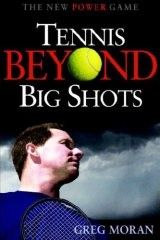March 2005 Article
Mortal Tennis/Circle Game Archive
Tennis Server
|

 |
If you read last month's column, Learn to Say "Too Good" you'll recall I wrote that more than eight out of ten points played (at every level of the game) are decided by an error. I also wrote that errors come in two flavors: forced and unforced. Sometimes our opponent forces us to miss because a shot, or series of shots, that they hit are just too tough for us to return. They simply beat us and that is when we must learn to say "too good" and move on to the next point. However, many times errors come as the result of nothing our opponent did but rather our own lack of patience or overly aggressive approach to the game. We try to hit the ball too hard, too low or to too small of an area and we miss. These are unforced errors. Both types of errors leave a bad taste in our mouths but unforced errors are particularly difficult to swallow because they are, in most cases, a result of our own loss of control, either physical or mental. Regardless of your level of play, unforced errors play a huge role in all of your matches. Simply put, the fewer you make, the greater the chance you'll have of walking off the court with a win. With that in mind, this month's column is dedicated to the reduction of unforced errors. In order to successfully battle the unforced error demon you must first change your approach to the game. This means throwing out the "go for it," "aim for the lines," "smack winners mentality" that is so popular these days. Yes, I know we all love to hit that great, net-skimming, line kissing rocket that our opponents enviously watch fly by. I've hit a few in my day and, you know what? They feel great! You clip the line and feel as if you've just won Wimbledon. The problem with those shots is that they lead us to believe that we can do it again and we become bound and determined to prove it. Fifteen to twenty unforced errors later, the memory of your "great" shot has been replaced by anger frustration and another notch in our loss belt. Trust me, when you hit that "great" shot it was, more often than not, a "lucky" shot. "Great" shots may get the crowd (if you actually play in front of one) on their feet but they seldom win tennis matches. What wins tennis matches are a lot of "pretty good" shots and a minimum amount of errors. Forget about the big/great/lucky shot approach to the game. The next time you step onto the court, take a deep breath and repeat the Mortal Tennis Players' mantra:
I refuse to miss.Repeat it as you go through your warm-up, in between points and during changeovers. This simple phrase will begin to tame the tennis devil inside of you that is constantly whispering into your ear those dreaded, unforced error inducing, words, "go for it." Let your opponent go for the winners, while you simply learn not to miss. Here are four tips that I give to my players that always, I repeat always, work:
Suggested Reading
This is not just a series of witty one-liners. From Bill Tilden up through Serena Williams, Fein has put together a treasure chest of quotes cleverly arranged to give us an inside look at the world's greatest game, it's issues and those who make it special.
This column is copyrighted by Greg Moran, all rights reserved.
Greg Moran is the Head Professional at the Four Seasons Racquet Club in Wilton, Connecticut. He is a former ranked junior and college player and certified by both the USPTA and USPTR. Greg has written on a wide variety of tennis-related subjects for numerous newspapers and tennis publications including Tennis, Tennis Match and Court Time magazines. He is also a member of the FILA and WILSON Advisory Staffs.
Questions and comments about these columns can be directed to Greg by using this form.
|



October 2022 Tennis Anyone: Patterns in Doubles by John Mills. September 2022 Tennis Anyone: Short Court by John Mills. |

 You will join 13,000 other subscribers in receiving news of updates to the Tennis Server along with monthly tennis tips from tennis pro Tom Veneziano.
You will join 13,000 other subscribers in receiving news of updates to the Tennis Server along with monthly tennis tips from tennis pro Tom Veneziano. 
